Současné projekty
Evoluce velikosti genomu – centromerický drajv v nové roli
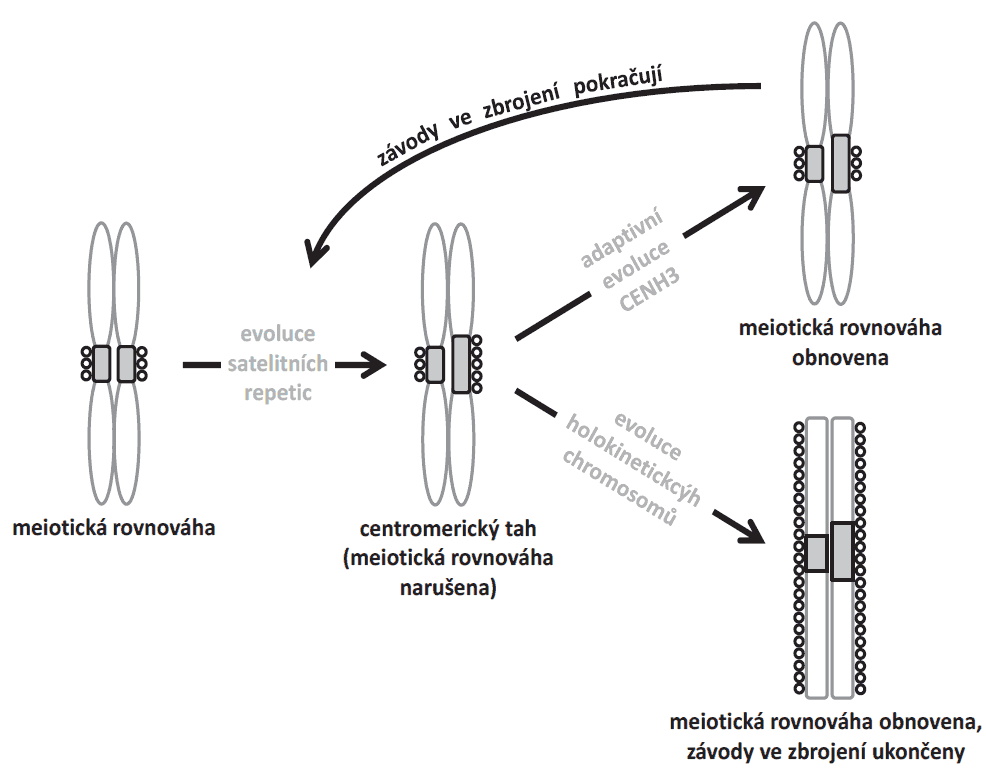 GAČR: 20-15989S, 2020–2022
GAČR: 20-15989S, 2020–2022
Vedoucí projektu: Petr Bureš
Zachování poměru velikostí chromozomů („zavazadel“) a jejich kinetochorů („držadel“), by mělo znamenat, že divergence velikostí kinetochorů, způsobená centromerickým drajvem, se odrazí v divergenci velikosti chromozomů živočichů a semenných rostlin a naopak v její stagnaci u hub, kapradin, plavuní a mechorostů, u nichž drajv neprobíhá. Tento dosud přehlížený vliv centromerického drajvu na velikost chromozomů a celých genomů chceme testovat srovnáváním tempa evoluce a divergence velikosti chromozomů u těchto linií eukaryot. Korelaci velikostí kinetochorů a chromozomů napříč druhy i uvnitř karyotypů budeme testovat u vybraných linií krytosemenných rostlin měřením imunofluorescenčně barvených kinetochorů jak na mitotických chromozomech, tak flow-cytometricky v interfázních jádrech (nová metoda), v kombinaci s pokročilými technikami chromozomálního paintingu. U linií krytosemenných s vysokým a nízkým tempem evoluce velikosti chromozomů budeme srovnávat selekční režimy působící na gen kinetochorového proteinu CENH3, abychom přímou souvislost s drajvem prokázali.
Hlavním cílem projektu je testovat vliv centromerického drajvu na divergenci a tempo evoluce velikosti chromozomů u živočichů a semenných rostlin a na stagnaci chromozomální velikosti u hub, mechorostů, plavuní a kapradin. Přímou kauzalitu a korelaci velikostí kinetochorů a chromozomů testovat u vybraných krytosemenných.
Eko-geografická limitace rostlinných polyploidů: experimentální testování nových hypotéz souvisejících s velikostí buněk
 GAČR: GA19-18545S, 2019–2021
GAČR: GA19-18545S, 2019–2021
Vedoucí projektu: Petr Šmarda
Tým: Petr Bureš, Lucie Horová, Ondřej Knápek, Alexandra Šilerová, Kristýna Veselá
Polyploidie má dalekosáhlé důsledky pro evoluci a ekologii rostlin. Jedním ze stálých efektů polyploidie je zvětšená velikost buňky. Ačkoliv je tento anatomický efekt znám vice než století, jeho důsledky pro ekologii a rozšíření rostlinných polyploidů jsou nejasné. S mými kolegy z Izraele jsme nedávno připravili první celosvětovou mapu rozšíření polyploidů a identifikovali proměnné prostředí, které nejvíce rozhodují o jejich regionálním úspěchu či neúspěchu. V projektu přicházím s několika nápady, jak by tyto proměnné prostředí mohli podporovat nebo limitovat polyploidy skrze jejich fyziologické vlastnosti ovlivnitelné velikostí buněk a rád bych otestovat tyto nápady v sérii kultivačních experimentů s použitím velkého souboru 23 párů diploidně-polyploidních taxonů. Konkrétně hodlám otestovat, že díky větším buňkám (hlavně průduchů) budou polyploidi růst hůře za zvýšené teploty, za sucha, za nízké koncentrace CO2, a že i přes větší množství fosforu v jejich větších jádrech nebude polyploidní pletivo tvořené většími buňky na fosfor náročnější než u diploidů.
Růstové strategie trvalek: od buněk k celým rostlinám
 GAČR: GA19-13231S, 2019–2021
GAČR: GA19-13231S, 2019–2021
Vedoucí projektu: Petr Šmarda
Tým: Lucie Horová, Ondřej Knápek, Jakub Šmerda, Kristýna Veselá, Jitka Klimešová, Tomáš Herben, Jana Martínková, Renáta Schnablová, Martin Weiser , Adam Klimeš, Tomáš Koubek
Vytrvalé byliny jsou druhově nejbohatší a fylogeneticky nejpestřejší skupinou temperátních flór. Jsou unikátní tím, že každoročně znovu vytvářejí nadzemní části ze zásob v podzemních orgánech. Pro svůj úspěch za různých ekologických režimů musí optimalizovat množství zásob, počet a velikost podzemních pupenů, buněk, načasování a rychlost růstu, preformaci orgánů. Rozmanitost jejich růstových strategií je tak mnohem větší než u jednoletek nebo stromů. Tato rozmanitost ale také je příčinou toho, že patří dosud k nejméně prozkoumané skupině temperátní flóry. V tomto projektu spojí síly tři vědecké skupiny, které se věnují jednotlivým aspektům růstu trvalek. Zjistíme mechanismy jejich růstu od buněčné úrovně až po úroveň celé rostliny a jejich závislost na prostředí. Propojení jednotlivých přístupů spolu se sběrem dat pomocí inovativních metod a fylogenetických, anatomických, cytometrických, experimentálních a modelovacích přístupů. To poprvé dovolí komplexně zkoumat růstové strategie trvalek a pochopit tak plně mechanismy určující jejich úspěch a roli v různých temperátních biotopech.
Úspěch holocentrických chromozómů: přírodní kompetiční experiment na globální evoluční škále
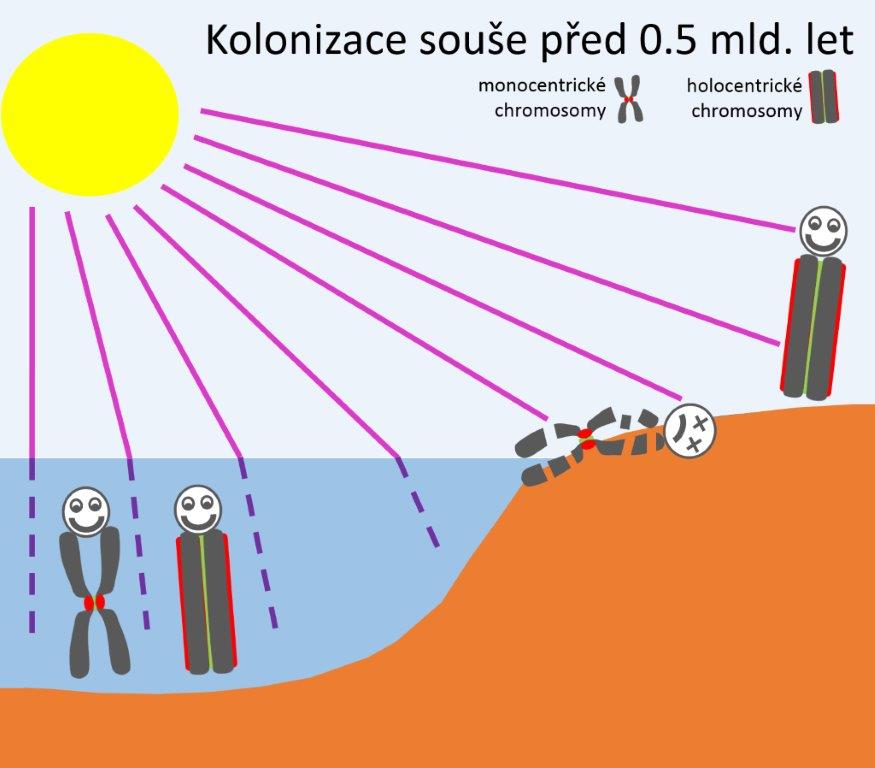 GAČR: 20-15989S, 2017–2019
GAČR: 20-15989S, 2017–2019
Vedoucí projektu: Petr Bureš
Tým: František Zedek, Petr Šmarda, Jakub Šmerda, Pavel Veselý, Lucie Horová, Ondřej Hájek, Jana Kocmanová
Holocentrická strukturní chromozomální alternativa vznikla vedle monocentrické nezávisle v řadě linií Eukaryot. Protože opakovaně v evoluci vzniká jen to, co je výhodné, je smyslem projektu takovou výhodu odhalit, což lze jen relativním srovnáním holo- a monocentriků. Druhovou a fylogenetickou diverzitu největší holocentrické linie krytosemenných (Cyperaceae + Juncaceae) budeme proto vztahovat k v mnoha směrech podobným, ale monocentrickým Poaceae na celosvětovém latitudinálním gradientu UV-B záření, jehož vyšší toleranci považujeme za klíč úspěchu holocentrismu. Budeme analyzovat i jejich kompetici, rozdíly v reakci na UV-B stres (endopolyploidie, obsah flavonoidů), v klíčení a přežívání na altitudinálních UV-B gradientech v přírodě i v řízených experimentech v klima-boxech. Obdobně chceme
analyzovat pomocí GBIF dat největší linii živočišných holocentriků (Lepidoptera) oprotiparalelním monocentrickým liniím hmyzu.
Hlavním cílem projektu je zjistit zda a za jakých podmínek holocentrické druhy lépe klíčí, přežívají, nebo kompetují s druhy monocentrickými a zda výhody na úrovni jedinců a populací podmiňují evoluční úspěšnost celých holocentrických linií v evoluční "kompetici" s příbuznými liniemi monocentriků.
Ukončené projekty
Environmental constraints on the evolution of plant genome architecture – regional and community scales perspectives
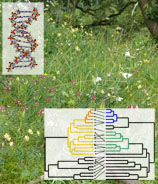 14-30313S Czech Science Foundation, 2014–2018
14-30313S Czech Science Foundation, 2014–2018
Project leader: Petr Šmarda
Team: Lucie Horová, Alexandra Březinová, Petr Bureš, Pavel Veselý, Ondřej Knápek, Jana Výhodová
In the project we aim to produce simple genomic data (monoploid genome size, genomic GC content and ploidy level) for complete vascular plant flora of the Czech Republic (> 2000 species). These data will be compared with available data on plant traits and their environments using phylogeny comparative methods. Contrary to previous studies, we aim to work with environments delimited with local species communities and by species pools of regional habitats. This will enable us to consider effect of species interactions and of different spatial scales. We hope that our project significantly improves understanding the role of the environment in shaping evolution of plant genomes as well as understanding the role of plant genome architecture in determining species’ ecology. The main objectives are (i) to detect and to estimate role of the environment in the evolution of plant genomes and by selection of species with different genomic architecture, (ii) to detect functional traits through that this selection operates and (iii) to find environmental factors that are forcing this selection.
Detection of Interspecific Gene Flow in the Genus Cirsium
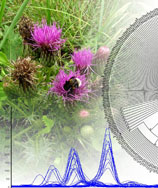 13-29362S Czech Science Foundation, 2014–2015
13-29362S Czech Science Foundation, 2014–2015
Project leader: Ester Lajkepová
Horizontal gene flow and genetic diversity are important determinants of evolutionary and speciation processes in higher plants, however they cannot be assumed to be general characteristics of all phylogenetic lineages. These determinants will be studied using a model genus Cirsium (thistle), which includes species with various intensity of recent hybridization in natural populations. For this purpose, nine species covering three model groups, were sampled: (a) frequently hybridising and widely distributed (C. oleraceum, C. palustre and C. rivulare); (b) limitedly hybridising and rarer (C. heterophyllum, C. acaule and C. canum) and (c) very rarely hybridising or non-hybridising (C. arvense, C. vulgare and C. eriophorum). The sampling was done in three eco-geographically diverse regions (White Carpathians, Brno and its surroundings and Žďárské vrchy Highlands). This project´s aim is to enrich the analysis of morphologically pure plants with a limited amount of hybrid plants. Based on AFLP method 780 samples will be analysed to detect: (i) presence/absence of gene flow within morphologically pure individuals, (ii) genetic diversity within the nine observed species and their populations, (iii) geographical structure of genetic diversity including local absence of some species and (iv) participation of hybrid plant types (F1, F2, BF1, ...) within the hybrid individuals of this unique model genus.
Evolution of holocentric chromosomes
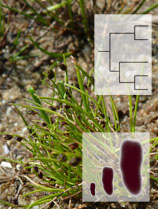 13-29362S Czech Science Foundation, 2013–2016
13-29362S Czech Science Foundation, 2013–2016
Project leader: Petr Bureš
Team: František Zedek, Lucie Horová, Pavel Veselý, Olga Rotreklová
An adaptive origin of holocentric chromosomes (without localized centromere) as a defense against centromere drive will be analyzed using selection regimes acting on kinetochore proteins. To explain surprisingly negative 2C/2n correlation and extreme divergences in holocentric chromosome sizes and numbers we propose a new evolutionary mechanism of “holokinetic drive” that will be tested by the study of segregation ratio of fragmented/non-fragmented homologs in the progeny of structural heterozygotes prepared via x-irradiation. Genome size, genomic GC%, portions and rates of particular modes of karyotype evolution (aneuploidy, polyploidy, chromosomal fusion/fission and repetitive DNA proliferation/removal) will be analyzed in holocentrics (Cyperaceae+Juncaceae, Chionographideae, Cuscuta subg. Cuscuta and Grammica, Drosera) and their sister monocentric clades using flow cytometry, chromosome counting and newly developed phylogenetic algorithm. A new detection technique combining irradiation and flow cytometry will be developed for an effective screening for holocentrism in plants.
Eco-geographical limitation of large genomes in angiosperms: a role of phosphorus
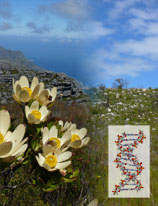 GAP505/11/0881 Czech Science Foundation, 2011–2014
GAP505/11/0881 Czech Science Foundation, 2011–2014
Project leader: Petr Šmarda
Team: Lucie Horová, Alexandra Březinová, Jana Výhodová, Ondřej Knápek, Adam Veleba, Pavel Veselý
This project is aimed to test several hypotheses explaining the controversy in the worldwide distribution pattern of angiosperm genome sizes. This project will namely revise formerly observed patterns taking in to the account phylogenetic dependence of observed characters in the design and statistical analyses of experiments, and will test possible limitation of polyploids and larger genomes in phosphorus deficient environments hypothesized recently by Leitch & Leitch (2008) in Science. Seven careful observational and manipulative experiments are designed to test the (i) suspected negative effect large genome size across tropical, temperate and high arctic flora, and in nutrient deficiency adapted groups of carnivorous plants; (ii) phosphorus limitation of larger genomes and polyploids in local floras (subarctic Svalbard, radiating flora of Cape region); and (iii) differences in growth performances of plants with different genome sizes (including comparison of diploid and tetraploid counterparts) in deficient sites using manipulative experiments.
Evolution of base composition in land plants
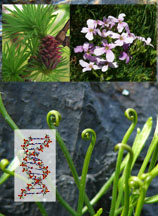 GAP506/11/0890 Czech Science Foundation, 2011–2014
GAP506/11/0890 Czech Science Foundation, 2011–2014
Project leader: Petr Šmarda
Team: Lucie Horová, Alexandra Březinová, Jana Výhodová
DNA base composition (GC content) is an important genomic and systematic character describing the proportion of nucleotides in the genome. GC content may vary with various structural and functional properties of genomes as shown namely in bacteria and vertebrates. The knowledge of GC content in plants in plants are still very poor in this respect and estimates of GC content are lacking in numerous groups such as in mosses and ferns. The main goal of this project is to detect differences and major trends in base composition among and within the five major evolutionary lineages of land plants (i.e., mosses, club mosses, ferns s.l., gymnosperms, angiosperms). A special interest is aimed to be paid to the ecological and evolutionary significance of being GC-poor or GC-poor not being tested in plants up to date, and to standardization of GC content measurements in plants.
Phylogeny of subtribe Hieraciinae (Asteraceae) – a model example of contrasting evolutionary strategies in closely related lineages
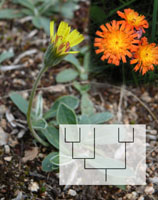 P506/10/1363 Czech Science Foundation, 2010–2013
P506/10/1363 Czech Science Foundation, 2010–2013
Project leader: Jindřich Chrtek
MU Investigator: Petr Bureš
Team: Olga Rotreklová, Jakub Šmerda
The tempo and mode of evolution in closely related sister lineages with contrasting ploidy levels and modes of reproduction is a timely topic of evolutionary biology. However, many studies are still confined to sequence data of a few gene regions only, to limited sampling, or to morphological characters. We offer a complex study of evolutionary trends in the subtribe Hieraciinae (which includes purely diploid sexual lineages as well as lineages with various proportions of polyploids with a versatility of breeding systems from sexuality to nearly obligate apomixis) using multigene sequencing, genome size, and other overall genomic attributes (GC content; amount, diversity, and physical localization of transposable elements)
Eco-geographical and genetic limitation of natural hybridization intensity
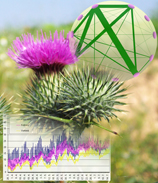 GA206/07/0859 Czech Science Foundation, 2007–2009
GA206/07/0859 Czech Science Foundation, 2007–2009
Project leader: Petr Bureš
Team: Karel Fajmon, Petr Šmarda, Olga Rotreklová, Shanju Sankar, Ondřej Hájek, Lubomír Tichý, Jakub Šmerda, Petra Blizňáková, Jiří Konečný, Jiří Žák
The main goal of the project is to explain the considerable differences in intensity of natural interspecific hybridization among the Central European Cirsium taxa, i.e. identification of the principal eco-geographic reproductive isolating barriers and estimation of their importance. The genus Cirsium was chosen as a model because the geographical distribution of its hybrids and intensity differences in interspecific hybridization are, compared to other frequently hybridizing genera (Viola, Carex, Verbascum, Epilobium, Salix), the best documented in natural conditions in the Central Europe. Additionally, Cirsium hybrids are easily morphologically determinable, and there are no serious taxonomic problems in this area. Natural interspecific hybridization intensity, expressed by numbers of specimens of hybrids in Czech herbaria, will be correlated with various models of geographical distribution similarities, flowering period overlap, reciprocal ecological affinities, genetic divergence (genome size, AT/GC genomic ratio, sequence of non-coding nrDNA and cpDNA) and hybrid success (pollen viability, seed fertility) of parental taxa in the relatively small but ecologically diversified area of the Czech Republic.
Biodiversity Research Center
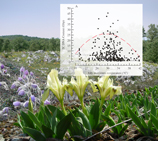 LC06073 Ministry of Education, Youth and Sports of the CR (LC – Basic Research Center) 2006–2010
LC06073 Ministry of Education, Youth and Sports of the CR (LC – Basic Research Center) 2006–2010
Project Manager: Pavel Kindlmann (Institute of System Biology and Ecology, Academy of Sciences Czech Rep.)
Deputy manager for Masaryk University: Petr Bureš
Team (Masaryk University): Petr Šmarda, Jakub Šmerda, František Zedek, Jiří Žák, Karel Fajmon, Olga Rotreklová, Vít Grulich, Jiří Danihelka, Luboš Tichý, Petra Blizňáková, Ondřej Hájek, Pavel Veselý, Samuel Lvončík
The main aim of the center is (i) create an effective network of research institutions involved in biodiversity studies in the Czech Republic; (ii) publish results in scientific journals (at least 100 papers in journals with IF>1); (iii) educate at least 40 young researchers in the field; (iv) become involved in at least 8 international projects or centers of excellence. Project involves the following institutions: Institute of System Biology and Ecology, Academy of Sciences Czech Rep. (leader P. Kindlmann); Charles University, Faculty of Science (leader D. Storch); Masaryk University, Working group for Plant biosystematics (leader P. Bureš); University of South Bohemia České Budějovice (leader O. Linhart); Institute of Entomology, Academy of Sciences Czech Rep. (leader V. Novotný); Institute of Animal Physiology and Genetics, Academy of Sciences Czech Rep. (leader P. Ráb), Institute of Botany, Academy of Sciences Czech Rep. (leader J. Danihelka); Institute of Vertebrate Biology, Academy of Sciences Czech Rep. (leader J. Zima)
Karyotype and genome size evolution in Cyperaceae
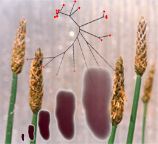 GA206/09/1405 Czech Science Foundation, 2009–2012
GA206/09/1405 Czech Science Foundation, 2009–2012
Project Leader: Petr Bureš
Team: František Zedek, Jakub Šmerda, Petr Šmarda, Olga Rotreklová, Ivana Hralová, Vít Grulich, Radomír Řepka, Jaroslav Mráček
Karyotype and genome size changes are one of the key mechanisms of evolution either below or above species level. In plants, where polyploidization is one of the main evolutionary forces, the knowledge of these processes is useful to correct interpretation of the molecular data in phylogeny reconstruction. While in the groups of organisms with monocentric chromosomes, the chromosome numbers are sufficient for the determination of ploidy level, in Cyperaceae is role of polyploidization on chromosome number change completely hidden by chromosomal fusion and fragmentation (symploidy and agmatoploidy) due to holokinetic nature of chromosomes. Because the polyploidy is not evaluated in this family, also the evolution of genome size remains poorly understood. Thus we offer to combine (i) molecular, (ii) flow cytometry and classical chromosome counting applied to particular species of two most contrasting model genera Carex and Eleocharis representing well this family. The main goal of the project is an analysis of patterns of genomic parameters: (i) genome size, (ii) chromosome number, (iii) chromosome size, (iv) genomic AT/GC composition, (v–vi) retrotransposon diversity and invasion in these models. Evolutionary dynamics of these species-specific genomic parameters in the framework of the phylogeny based on molecular sequence markers will be used for the evaluation of the role of key mechanisms in genome size and karyotype evolution: (i) polyploidy; (ii) agmatoploidy, (iii) symploidy, (iv–v) retrotransposon amplification or removal in the main evolutionary lineages of taxa studied. Therefore in our project, the model is not a concrete species as in classical genomic studies but the group of species connected by the net of their evolutionary relationships. The models Eleocharis and Carex are contrasting in (i) number of species, (ii) evolutionary centers, (iii) ecological diversification, but mainly in (iv) chromosome and genome size variation ranges, which is in Eleocharis one of the largest known among angiosperms genera.
GC content and genome evolution of grasses
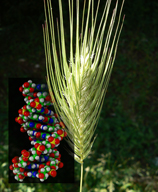 Grant Agency of the Czech Republic No. 206/08/P222, 2008–2010
Grant Agency of the Czech Republic No. 206/08/P222, 2008–2010
Project Leader: Petr Šmarda
Marie Holčáková, Lucie Horová, Jiří Rozehnal, Věra Slezáková, Jakub Šmerda
The main goal of this project is to survey of variability in GC bases content (guanine and cytosine) related to species phylogeny and global genome evolution. The study will be devoted to model family Poaceae (grasses), typical of highest and most variable GC content within higher plants, and will concern all hierarchical levels, from inter-family, inter-generic, inter-specific, to intra-specific differences. Particular studies are devoted to (i) map the origin and consecutive evolution of high GC content of grass genomes and genes within Monocots, (ii) survey variability of GC content and chromosome size among main grass evolutionary lineages, (iii) test evolutionary significance of high GC content and thus higher DNA thermostability for plants from extreme climatic conditions, (iv) prove relation of GC content variability with transposable elements-driven genome expansions and contractions (on inter-specific level in genus Oryza, on intra-specific in Festuca pallens), and (v) to prove possible application of GC content and genome size measurements in the mapping of these processes.
Microevolutionary aspects of residual sexuality in apomictic plants: detection, rate and manifestation in populations of Hieracium subgen. Pilosella
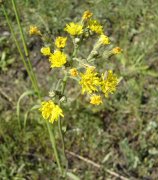 Grant Agency of the Czech Republic 206/07/0059, 2007–2009
Grant Agency of the Czech Republic 206/07/0059, 2007–2009
Leader: Anna Krahulcová (Botanical Institute of the Czech Academy of Sciences)
Member: Olga Rotreklová
Facultative apomixis combines usually dominant asexual seed production and occasional hybridization of maternal plants (residual sexuality). Advantages of both apomixis (fixation and spread of adapted genotypes) and sexuality (increase of progeny variation by recombination and segregation) often contribute to invasion of such biotypes to new habitats. Besides sexual biotypes, also facultative apomicts do hybridize (as seed or pollen parents) in our model system of Hieracium subgenus Pilosella. Thus, both recent hybrids and already stabilized hybridogenous taxa occur in nature. The project is aimed at 1) detection and quantification of hybrid progeny of apomitic mothers after experimental crosses and open pollination in the field, and 2) evaluation of progeny variation generated by apomictic versus sexual mothers in selected mixed populations. Comparison to actual population structures in the wild will provide an estimate of establishment of new biotypes originated in the same way and elucidate the role of natural selection.
Herbarium, vivae icones – electronic learning tool for plant identification
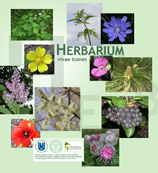 Ministry of education, Czech Republic, 2006
Ministry of education, Czech Republic, 2006
Leader: Petr Bureš
Member: Pavel Veselý
The main goal of project Herbarium, vivae icones is reinforcement of the teaching of botany of students focused on scientific specializations and particularly students of the education of biology – future teachers of secondary schools. Project is based on using of multi-medial instruments as (i) electronic herbarium in both web and CD-ROM version containing photos of 361 live plants (scans and detail photos of habitus, flowers, leaves, and other structural features important from the determination viewpoint; – (ii) communicative interface offering various forms of learning, testing in both web and CD forms based on programming script PHP in combination with JavaScript in Macromedia Flash; – (iii) two complete series of herbarium specimens of these species protected by lamination; – (iv) electronic version of herbarium used for examination. The financial resources cover purchase of A3 scanner, digital photo camera; external HDD, CD-ROMs, and costs for lamination of herbarium specimens. The project particularity is based on (i) species selection: the most frequent and most typical species for the area of the Czech Republic; – (ii) style of figures: scanning of live plants; – (iii) stimulating communicative interface.
Phylogeography of polyploid complexes in Europe
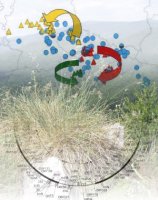 Grant Agency of the Czech Republic 206/03/0228, 2003–2005
Grant Agency of the Czech Republic 206/03/0228, 2003–2005
Leader: Petr Bureš
Members: Karol Marhold (Botanical institute of Slovak Academy of Science); Lucie Horová and Petr Šmarda
The main goal of the project is an analysis of patterns of genetic variation in polyploid complexes representing different groups of vascular plants in connection with their evolution and geographical distributions. Groups with known aneuploidy and with holocentric chromosomes are included, as are groups with no chromosome number variation at given ploidy levels. Model species groups or groups with infraspecific variation include Eleocharis uniglumis, Festuca pallens, Cardamine amara, Cardamine raphanifolia and Cardaminopsis arenosa. This research will be conducted by comparing non-coding chloroplast trnL(UAA) intron and trnL(UAA)-trnF(GAA) intergenic spacer DNA sequences and by studying the absolute and relative DNA content variation within and between populations.
Vascular plants of the UNESCO Biosphere Reserve Pálava
 Czech Science Foundation 206/01/P115, 2000–2003
Czech Science Foundation 206/01/P115, 2000–2003
Leader: Jiří Danihelka
The Pálava Biosphere Reserve (BR), designated in 1986, is situated in the southern part of the Czech Republic, close to the border with Austria and Slovakia. It consists of limestone hills covered by dry grasslands, a gently rolling hill country with thermophilous oak forests and oak-hornbeam forests, floodplain of the Morava and Dyje Rivers with alluvial forests and meadows, as well as urban habitats and agricultural land. It is the warmest and driest part of Czechia, with many Pontic-Pannonian and Submediterranean species present in its flora. In 1992, J. Danihelka, V. Grulich and K. Šumberová, all Masaryk University, started grid mapping Pálava's vascular plants. The grid is based on geographical coordinates and is derived from the Central European grid system with fields 10 x 6 geographical minutes further divided in to 10 x 10 elementary fields (EF; each about 1.36 km2). The area mapped is about 300 km2 in extent and consists of 261 partly or fully covered EFs. For each EF at least one recording form exists, and each area is visited in all three seasons. The records have been stored in a recently developed database SurveyPro (with a simple geographic information system built in; http://janitor.cenia.cz). January 2004, the database contained 127.500 records. Recent data is supplemented with a survey of literature sources, and records are stored into the database MABFlora. In January 2004, about 580 sources were searched for relevant data, and records for about 1949 taxa are now held in the database. A catalogue of BR's vascular plants is being compiled.
Phylogenetic analysis of Poa L. on the basis of non-coding cpDNA sequences
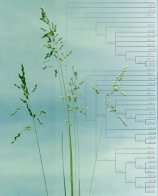 Ministry of education, Czech Republic, 2003
Ministry of education, Czech Republic, 2003
Leader: Sierra Dawn Stoneberg Holt
The aim of this project is to study the infrageneric variability within the sequences of the non-coding chloroplast DNA regions of the trnL intron and trnL-trnF IGS within the genus Poa L. These sequences will also serve as an expanded outgroup for the phylogeographic analysis of European and North American populations of Poa pratensis agg.
Molecular taxonomy of Lemanea in the Czech Republic
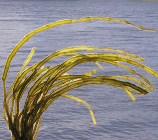 Ministry of education, Czech Republic, 2003
Ministry of education, Czech Republic, 2003
Leader: Pavel Kučera
The main aim of project was isolation of 18S rDNA gene sequences from the nature populations in the Czech Republic and construct the phylogenetic hypothesis. The results show Lemaneaceae as a monophyletic group among the other rhodophytes and confirmed the clear difference between Lemanea and Paralemanea with high bootstrap values. On the other hand no differences at the species level were found. The results correspond with morphological investigation of Paralemanea species, whereas Lemanea fluviatilis and L. torulosa appear to be morphologically well-defined species.
We also participate
 Diversity of Biotic Communities and Populations: Causal Analysis of Variation in Space and Time
Diversity of Biotic Communities and Populations: Causal Analysis of Variation in Space and Time
Long-term Research Plan MSM 0021622416 (2005–2011)
Funded by Ministry Of Education, Youth and Sports of Czech Republic
Research Plan Coordinator: Milan Chytrý
 Spatial and Temporal Biodiversity Dynamics in Ecosystems of Central Europe
Spatial and Temporal Biodiversity Dynamics in Ecosystems of Central Europe
Long-term Research Plan MSM 143100010 (Formerly CEZ: J07/98:143100010) – VZ MU 0429 (2000–2004)
Funded by Ministry Of Education, Youth and Sports of Czech Republic
Research Plan Coordinator: Jaromír Vaňhara
 Identification key of ferns and flowering plants of the Slovak Republic
Identification key of ferns and flowering plants of the Slovak Republic
Grant Agency VEGA no. APVT-51-026404 (2005–200?)
Scientific person in charge at the IB SAS: Karol Marhold
Editorial Committee (alphabetically): Viera Feráková, Vít Grulich, Iva Hodálová, Lubomír Hrouda, Judita Kochjarová, Karol Marhold, Pavol Mártonfi, Pavol Mereďa
The goal of the project is a preparation and publication of the Identification Key of Ferns and Flowering Plants of Slovakia. The key will provide a tool for determination of all the vascular taxa given in the Checklist of Non-vascular and Vascular Plants of Slovakia (Marhold & Hindák 1998). It will be based on the published volumes of Flora of Slovakia, taking into account the most recent knowledge about the particular taxa. For taxa not covered by the published volumes of Flora of Slovakia new identification keys will be prepared. The introductory chapters will contain brief morphological glossary, brief history of botanical research in Slovakia, survey of phytocoenological units (at the level of alliance), and of families, phytogeographic survey of Slovakia, instruction for use and list of references. The Identification Key will also contain brief characteristics of species and subspecies (+ review of hybrids), including data on discriminant characters, flowering period, chromosome numbers, category of threat, ecology, phytocoenology, and distribution in Slovakia. The most common synonyms will be listed as well. Diagnostic features of plants will be shown by the illustrations. It is expected that a group of specialists in phytocoenology will closely cooperate on this project.
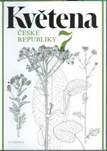 Flora of the Czech Republic – finalization
Flora of the Czech Republic – finalization
Grant Agency of the Czech Republic No. 206/07/0706 (2007–2009, GA0/GA)
Participant: Vít Grulich
Among the basic works of the Czech botanical literature, the nine-volume Flora of the Czech Republic represents the most extensive and comprehensive encyclopaedia. The seven volumes published since 1988 to 2004 include the treatment of 2576 numbered species. This project aims to finalize this compendium. Particular objectives are: to finalize editorial work on vols. 8 and 9; to make Supplement to previously published volumes. This Supplement will effectively synthesize the most important floristic and taxonomic information published since 1988. It will include all taxa of territory of the Czech Republic discovered as new since the original treatment, data on changes in distribution, up-to-date lists of endemic taxa and taxa described from the territory of CR, lists of additional chromosome numbers and bibliography, statistical tables and an index to vols. 1–9. Such completed Flora will be indispensable as a source of information for the width scientific community, managements of resources.
 Flora of the Czech Republic, Vol. 8/2
Flora of the Czech Republic, Vol. 8/2
(Grant Agency of the Czech Republic No. 206/98/1545, 2004–2006, project leader Bohumil Slavík)
Flora of the Czech Republic, Vol. 8/1
(Grant Agency of the Czech Republic No. 206/01/1115, 2001–2003, project leader Bohumil Slavík)
Flora of the Czech Republic, Vol. 7
(Grant Agency of the Czech Republic No. 206/98/1545, 1998–2000, project leader Bohumil Slavík)
List of all participants and treated genera from all volumes
 Vegetation diversity along a continentality gradient in southern Siberia: a key to understanding Early Postglacial History of Central Europe
Vegetation diversity along a continentality gradient in southern Siberia: a key to understanding Early Postglacial History of Central Europe
(Grant Agency of the Academy of Sciences of the Czech Republic, 2003–2007).
Participants: Petr Šmarda and Jiří Danihelka






